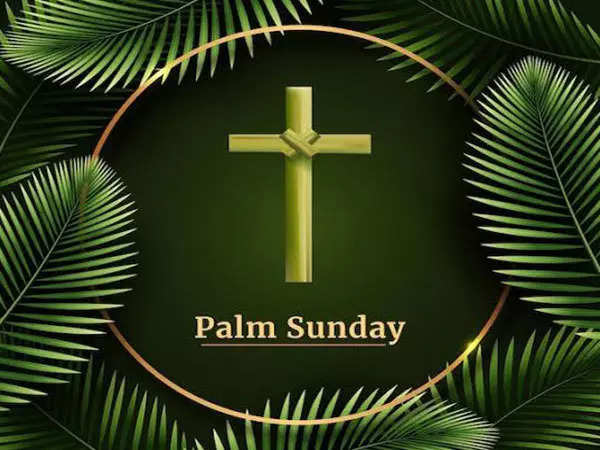Welcome to the vibrant celebration of Palm Sunday! This special day marks the beginning of Holy Week, leading up to Easter Sunday. Palm Sunday commemorates Jesus Christ’s triumphant entry into Jerusalem, where He was welcomed with crowds waving palm branches and laying them on the ground before Him.
Incorporating the brand voice, we invite you to join us as we delve into the rich traditions and significance of this momentous occasion. As the excited shouts of “Hosanna!” resounded through the streets of Jerusalem, the atmosphere was filled with anticipation and hope.
This article will explore the historical and biblical context of Palm Sunday, shedding light on its symbolism and spiritual meaning. Discover how this joyful procession serves as a reminder of Jesus’ love, sacrifice, and His ultimate mission of redemption. We’ll also delve into the customs and traditions associated with Palm Sunday around the world, showcasing the diverse ways in which this joyous event is celebrated.
So, let’s journey together and immerse ourselves in the profound significance of Palm Sunday, as we prepare our hearts and minds to embrace the transformative message of Easter.
What is Palm Sunday?
Palm Sunday, also known as Passion Sunday, is an important Christian festival that falls on the Sunday before Easter. It commemorates Jesus Christ’s entry into Jerusalem, a week before His crucifixion and resurrection. The name “Palm Sunday” originates from the palm branches that were waved and laid on the ground as a gesture of honor and respect for Jesus as He rode into the city on a donkey.
The significance of Palm Sunday is deeply rooted in the biblical narrative, symbolizing the fulfillment of ancient prophecies and the beginning of the final chapter in Jesus’ earthly ministry. It serves as a pivotal moment in the Christian calendar, setting the stage for the events that would unfold during Holy Week.
Palm Sunday holds great spiritual significance for Christians worldwide, as it marks the start of the journey towards redemption and salvation. It serves as a timely reminder of Jesus’ unconditional love, His sacrificial death on the cross, and the hope of eternal life through faith in Him.
Biblical references to Palm Sunday
The biblical accounts of Palm Sunday can be found in all four Gospels: Matthew, Mark, Luke, and John. Each Gospel provides unique details and perspectives on this momentous event, offering a comprehensive understanding of its significance.
In Matthew 21:1-11, we read about Jesus’ triumphant entry into Jerusalem. The crowds welcomed Him with great enthusiasm, spreading their cloaks and palm branches on the road as a symbol of honor and royalty. The people shouted, “Hosanna to the Son of David! Blessed is he who comes in the name of the Lord!”
Mark 11:1-11 recounts a similar story, emphasizing the fulfillment of prophecy as Jesus rode on a donkey, just as Zechariah had prophesied centuries earlier. The people hailed Him as the coming King, exclaiming, “Hosanna! Blessed is he who comes in the name of the Lord!”
Luke 19:28-44 provides further insight into the events of Palm Sunday, highlighting the emotional response of Jesus as He wept for the city of Jerusalem. This passage also emphasizes the divine purpose behind Jesus’ entry into the city, setting the stage for the ultimate sacrifice He would make for humanity.
John 12:12-19 describes the crowd’s jubilant reception of Jesus as He entered Jerusalem. The people, having witnessed His miracles and teachings, eagerly welcomed Him as the long-awaited Messiah. They waved palm branches and cried out, “Hosanna! Blessed is he who comes in the name of the Lord, even the King of Israel!”
These biblical references to Palm Sunday convey the profound significance of this event in the life and ministry of Jesus Christ. They remind us of His eternal kingship, His humble nature, and His willingness to embrace the path of suffering for the sake of humanity’s redemption.
Palm Sunday traditions and customs
Palm Sunday is celebrated with various traditions and customs around the world, each reflecting the unique cultural heritage and religious practices of different communities. These customs serve to enhance the spiritual experience and create a sense of unity among believers.
One of the most common traditions associated with Palm Sunday is the distribution of palm branches or palm crosses. These are blessed by clergy and then distributed to the congregation during church services. The palm branches are often taken home and displayed as a reminder of Jesus’ triumphal entry into Jerusalem.
In some countries, especially in regions where palm trees are not readily available, branches of other trees, such as olive or willow, are used as substitutes. The significance lies not in the specific type of branches used, but rather in the act of waving them as a symbol of praise and worship.
Another popular custom observed on Palm Sunday is the reenactment of Jesus’ entry into Jerusalem through processions. These processions may take place both inside and outside the church, with participants carrying palm branches and singing hymns of praise. The procession represents the joyous welcome that Jesus received from the crowds as He entered the city.
In addition to these customs, many churches incorporate special liturgical elements into their Palm Sunday services. These may include the reading of the Passion narrative, the singing of hymns specific to Palm Sunday, and the blessing of palms or other branches. These traditions and customs collectively contribute to the unique and meaningful celebration of Palm Sunday.
Celebrating Palm Sunday around the world
Palm Sunday is celebrated with great enthusiasm and devotion in various parts of the world, each region adding its own cultural flair to the festivities. Let’s explore some of the diverse ways in which this joyous occasion is commemorated globally.
In Spain, particularly in the city of Seville, Palm Sunday is marked by elaborate processions known as “Semana Santa” or Holy Week. These processions feature religious statues, beautifully decorated floats, and participants dressed in traditional robes. The streets are lined with spectators, and the air is filled with the sounds of music and incense as the processions make their way through the city.
In the Philippines, Palm Sunday is celebrated with the renowned “Palm Sunday Passion Play” in the town of Marinduque. This play reenacts the events of Jesus’ entry into Jerusalem, His trial, crucifixion, and resurrection. It is a grand theatrical production, attracting both locals and tourists who come to witness the powerful portrayal of the Easter story.
In Greece, Palm Sunday is known as “Vaios” or “Flower Sunday.” On this day, people carry palm branches, flowers, and olive branches to church to be blessed. After the church service, families gather for a festive meal, enjoying traditional Greek delicacies and spending quality time together.
These are just a few examples of how Palm Sunday is celebrated around the world. The diversity of customs and traditions serves as a testament to the universal significance of this joyous occasion, transcending cultural boundaries and uniting believers in their faith.
Palm Sunday symbols and their meanings
Palm Sunday is rich in symbolism, with various elements carrying profound meanings that deepen our understanding of this sacred day. Let’s explore some of the symbols associated with Palm Sunday and their spiritual significance.
The palm branch is perhaps the most recognizable symbol of Palm Sunday. It represents victory, triumph, and the recognition of Jesus as the Messiah. The waving of palm branches by the crowds in Jerusalem symbolized their acknowledgment of Jesus’ authority and their hope of liberation from oppression.
The donkey, on which Jesus rode into Jerusalem, also holds symbolic importance. In biblical times, donkeys were associated with humility, peace, and royalty. Jesus’ choice of a donkey as His mode of transportation demonstrated His humility and the peaceful nature of His kingdom.
The shouts of “Hosanna!” that echoed through the streets of Jerusalem on Palm Sunday carry a profound meaning. “Hosanna” is an exclamation of praise and adoration, derived from the Hebrew word meaning “Save us, we pray.” The people recognized Jesus as their Savior, expressing their desperate need for His salvation and deliverance.
Palm Sunday crafts and activities for kids
Palm Sunday provides an excellent opportunity for children to engage in creative and educational activities that deepen their understanding of the significance of this day. Here are some fun and meaningful crafts and activities that you can enjoy with your kids:
- Palm Branch Crafts: Help your child create their own palm branch by cutting out palm-shaped leaves from green construction paper or cardstock. They can then decorate the branches with crayons, markers, or even glitter to add a touch of sparkle.
- Palm Sunday Coloring Pages: Print out coloring pages related to Palm Sunday, such as images of Jesus riding on a donkey or palm branches. Encourage your child to color the pages while discussing the story and its meaning.
- Palm Sunday Procession: Organize a mini-procession in your backyard or living room, complete with palm branches and joyful singing. Encourage your child to take turns role-playing as Jesus, His disciples, and the cheering crowd. This activity helps them understand the events of Palm Sunday in a hands-on and interactive way.
- Palm Sunday Storytelling: Read age-appropriate books or Bible stories that explain the events of Palm Sunday in a simple and engaging manner. Encourage your child to ask questions and discuss the story, helping them grasp its spiritual significance.
These crafts and activities provide a wonderful opportunity for children to connect with the story of Palm Sunday and deepen their understanding of its meaning. As they engage in these creative endeavors, they will not only have fun but also develop a lasting appreciation for the significance of this important day in the Christian calendar.

Palm Sunday hymns and songs
Music plays a vital role in the celebration of Palm Sunday, adding a powerful and emotive dimension to the worship experience. Hymns and songs specifically associated with Palm Sunday contribute to the overall atmosphere of joy and reverence. Here are some popular hymns and songs that are often sung on Palm Sunday:
- “All Glory, Laud, and Honor”: This traditional hymn captures the spirit of Palm Sunday, with lyrics that exalt Jesus as the King who is worthy of all honor and praise. The melody is uplifting and joyful, making it a favorite choice for congregational singing.
- “Ride On, Ride On in Majesty”: This hymn vividly describes the events of Jesus’ triumphal entry into Jerusalem, inviting the listener to participate in the joyful procession. The lyrics beautifully convey the anticipation and excitement that filled the air on that fateful day.
- “Hosanna, Loud Hosanna”: This hymn echoes the shouts of “Hosanna!” that resounded through the streets of Jerusalem. The lyrics express adoration and praise for Jesus, acknowledging Him as the promised Messiah and King.
In addition to these hymns, many contemporary worship songs also capture the essence of Palm Sunday, evoking a sense of celebration and awe. As believers join together in singing these songs, they are reminded of Jesus’ triumphal entry and are encouraged to worship Him with joyful hearts.
Palm Sunday sermons and messages
Palm Sunday sermons and messages focus on the biblical narrative, drawing out its relevance and application to our lives today. They explore the themes of Jesus’ kingship, His humility, and the call for believers to respond with faith and devotion. Here are some key messages often highlighted in Palm Sunday sermons:
- Jesus as the Humble King: Palm Sunday highlights Jesus’ humble nature, as He chose to ride on a donkey instead of a majestic horse. This serves as a powerful reminder that true greatness is found in humility and service.
- The Fulfillment of Prophecy: Palm Sunday marks the fulfillment of ancient prophecies, underscoring the divine nature of Jesus’ mission. This emphasizes the trustworthiness of God’s promises and the certainty of His plans.
- The Call to Worship and Surrender: The shouts of “Hosanna!” on Palm Sunday reflect a heart of worship and surrender. Believers are called to respond with wholehearted devotion, acknowledging Jesus’ authority and lordship in their lives.
Palm Sunday sermons encourage believers to reflect on Jesus’ entry into Jerusalem and consider how they can respond with faith, humility, and surrender. They invite individuals to embrace the transformative message of Easter and deepen their relationship with Jesus.










